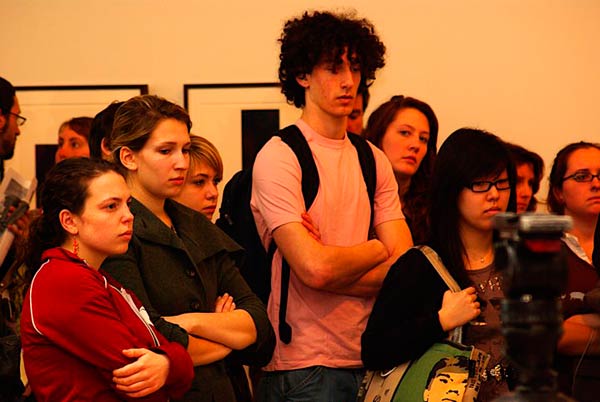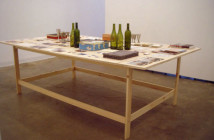BRANDEIS STUDENTS: SAVE THE ROSE
The alarming rumors that Brandeis would be deeply affected by the looming economic recession, and the recent Madoff ponzi scheme scandal, set a decidedly anxious tone for the Winter/Spring 2009 semester. Statements that 10% of faculty would be cut, alongside the “downsizing” of interdisciplinary studies programs, was enough to keep both students and teachers quiet and productive, fearing our majors or jobs were next to go. Little did we know that the most startling revelation was still the secret of a trustee boardroom, a shattering decision that was sprung on the general student body via email on the evening of January 26: the Rose is closing, its collection being sold, and its carcass will be converted into studio space. Love, Jehuda Reinharz.
As masters students in the Cultural Production Department, focusing on museum studies, this is obviously all we could talk about. Old friends left us messages on Facebook asking if our school had gone crazy. Concerned parents called to see if it was time to transfer to another institution. Despite the initial panic, we quickly found ourselves privy to a unique perspective on the inner workings of the art world, a position both hideous and historic in nature. Shock quickly shifted to ideas for action, and we were compelled to immediately and effectively challenge both the legitimacy and finality of the Rose’s imminent demise.
Concerned students and alumni almost instantly threw up a Facebook group and website to Save The Rose, collecting donations, petitions, virtual bodies, and information in efforts to combat the decision of seemingly insane trustees. Faculty bravely stood up to prevent this decision and craft alternatives. Still, an overwhelming feeling of inevitability hung over all the proceedings, a notion driven home by Rose Director Michael Rush at a museum sit-in on Wednesday: the Rose, as we all know and have known it, can and will never be the same. The institution’s place at Brandeis, in the museum world, and to art lovers has been deeply altered. So, what to do with this nervous energy, with fear and frustration? How can we defend the character of the students, since the university is determined to publicly execute its own reputation?
The “unanimous” decision by the trustees to liquidate The Rose’s outstanding permanent collection of contemporary and modern art was not only ill advised, but destructive to the entire Brandeis community. We demand a more detailed explanation as to how this decision was reached, and an explanation of exactly what the administration thinks its students of art have to look forward to. We pay to go here, we chose this school for its outstanding connection to and preservation of art. What would then keep us here, and what makes us think our hard-earned degrees can retain their prestige? Excellent faculty cannot save us – every job interview from now on will have to include a conversation about the Rose, a defense of our persons in the face of institutional suicide.
Both to save our selves and the museum, physical demonstrations of disagreement sprang up. The student-led sit-in at the Rose was the first collaborative outward response to the closing of the museum. On Wednesday, January 8, the first floor of the museum was packed with Rose supporters and with individuals that realized that the clock was ticking on their chance to view exhibitions and items from the collection. Students and community members gave compelling speeches, but nobody’s words carried more weight than those of Michael Rush. He announced the finality of the decision, his anger over not being a part of the process, and most importantly encouraged students to keep making noise. Rush’s concern for students here was obvious; despite the terminal nature of his position, his endorsement of our call to arms is of great inspiration, almost a coded message that we still have a lot of art to make, research to do, and perhaps this is the single defining moment of our educations.
COMESEEART, a visual protest against this decision, served as a meeting place for student leaders, graduate and undergraduate, to cook up a continued resistance. Using projected and reproduced images directly from the archives at the Rose, we provided a slideshow-style visual backdrop of fleeting, pixelated imagery to evoke both a sense of loss and ownership: these reproductions weren’t real like the objects they stand in for, however, soon they will be all we have left. Our degrees may decrease in value, but they are still ours, and our hands are not tied. What is to keep us from using the campus as an exhibition space? Is ongoing protest useless in light of the finality of the decision to sell the collection?
We shall see if the administration attempts to crush further protest and if our continued action keeps the Museum open. Regardless, from now on at the campus of Brandeis University, art objects will appear in embarrassing places, funeral processions will haunt the Campus Center, and everyone will know that this decision was not of or for the benefit of students. Through a developing coalition of organizers and artists, graduates and undergraduates, there will be no silent cooperation here; if we cannot save the museum, then its dramatic deaccession must be publicly mourned for years to come.
- Students, faculty and Rose staff stage a sit-in protest
- Students, faculty and Rose staff stage a sit-in protest
- Students, faculty and Rose staff stage a sit-in protest
Photos by Bryce Peake and Sarah Stephenson.







